 Open Access Article
Open Access ArticleCreative Commons Attribution 3.0 Unported Licence
Enhanced photoelectrochemical performance of composite photovoltaic cells of Li+@C60–sulphonated porphyrin supramolecular nanoclusters†
Kei
Ohkubo
a,
Yuki
Kawashima
a,
Hayato
Sakai
b,
Taku
Hasobe
*b and
Shunichi
Fukuzumi
*ac
aDepartment of Material and Life Science, Graduate School of Engineering, Osaka University and ALCA, Japan Science and Technology Agency (JST), 2-1 Yamada-oka, Suita, Osaka 565-0871, Japan. E-mail: fukuzumi@chem.eng.osaka-u.ac.jp; Fax: +81-6-6879-7370; Tel: +81-6-6879-7368
bDepartment of Chemistry, Faculty of Science and Technology, Keio University, Yokohama, 223-8522, Japan. E-mail: hasobe@chem.keio.ac.jp
cDepartment of Bioinspired Science, Ewha Womans University, Seoul, 120-750, Korea
First published on 26th March 2013
Abstract
A photoelectrochemical solar cell composed of supramolecular nanoclusters of lithium encapsulated fullerene and zinc sulphonated meso-tetraphenylporphyrin exhibits significant enhancement in the photoelectrochemical performance as compared with the reference system containing only a single component.
Photoelectrochemical cells (PECs) have been widely investigated as a next-generation solar cell because of their simple structure.1–3 The photoinduced charge separation between the excited state of dye and the electrode plays an important role in improvement of PEC performance. In the natural photosynthetic reaction centre, the efficient photoinduced electron transfer occurs to give a long-lived charge separated (CS) state with high quantum yield.4 Extensive efforts have so far been devoted to design and synthesize electron donor–acceptor linked molecules to achieve efficient photoinduced charge separation for applications to PECs.5,6 However, the synthetic difficulty of the covalently linked donor–acceptor molecule has precluded the development of simple photovoltaic devices using such model compounds of the photosynthetic reaction centre. Among many candidates, porphyrins and fullerenes are a suitable combination for the construction of PECs, because porphyrins have strong visible absorption bands and fullerene exhibits efficient electron-transfer properties such as small reorganization energy due to the delocalized three-dimensional π-system.7 The supramolecular approaches for PECs are also investigated, however, there was no report of supramolecules with a strong binding between neutral porphyrins and fullerenes.
We have recently designed and synthesized simple electron donor–acceptor supramolecular complexes composed of lithium ion encapsulated fullerene (Li+@C60) and sulphonated meso-tetraphenylporphyrin (MTPPS4−: M = Zn, H2), which have strong 1![[thin space (1/6-em)]](https://www.rsc.org/images/entities/char_2009.gif) :
:![[thin space (1/6-em)]](https://www.rsc.org/images/entities/char_2009.gif) 1 supramolecular binding due to the cation–anion and π–π interactions (K = ∼105 M−1).8 Photoexcitation of the supramolecule exhibited extremely slow charge-recombination of the CS state (τ = 0.3 ms) in benzonitrile (PhCN).8 Li+@C60 has been reported to act as a more effective electron acceptor than pristine C60.9 The driving force of photoinduced electron transfer from MTPPS4− to the triplet excited state of Li+@C60 is highly positive (−ΔGET = 0.98 eV for ZnTPPS4− and 0.67 eV for H2TPPS4− in polar PhCN),8 which is large enough to afford the CS states even under the non-polar environment in nanoclusters.
1 supramolecular binding due to the cation–anion and π–π interactions (K = ∼105 M−1).8 Photoexcitation of the supramolecule exhibited extremely slow charge-recombination of the CS state (τ = 0.3 ms) in benzonitrile (PhCN).8 Li+@C60 has been reported to act as a more effective electron acceptor than pristine C60.9 The driving force of photoinduced electron transfer from MTPPS4− to the triplet excited state of Li+@C60 is highly positive (−ΔGET = 0.98 eV for ZnTPPS4− and 0.67 eV for H2TPPS4− in polar PhCN),8 which is large enough to afford the CS states even under the non-polar environment in nanoclusters.
We report herein photovoltaic cells using Li+@C60–MTPPS4− nanoclusters, which are assembled on the optically transparent electrode (OTE) of nanostructured SnO2 (OTE/SnO2). The photoelectrochemical behaviour of the nanostructured SnO2 film of supramolecular nanoclusters between Li+@C60 and MTPPS4− denoted OTE/SnO2–(MTPPS4−–Li+@C60)n is significantly higher than the single component films of MTPPS4− or Li+@C60 clusters, denoted OTE/SnO2–(MTPPS4−)n or OTE/SnO2–(Li+@C60)n (Scheme 1).
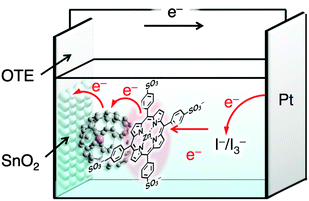 | ||
| Scheme 1 Schematic image of a photoelectrochemical cell of OTE/SnO2–MTPPS4−–Li+@C60. | ||
A solution of Li+@C60–MTPPS4− supramolecule was prepared by mixing Li+@C60PF6− (2.5 × 10−4 M) and (Bu4N+)4 MTPPS4− (2.5 × 10−4 M) in PhCN. The mother PhCN solution of 1 mL was injected to an acetonitrile (MeCN) solution (3 mL) to produce the suspension containing the supramolecular nanoclusters [(MTPPS4−–Li+@C60)n]. The suspension of (MTPPS4−–Li+@C60)n was transferred into a cuvette, in which the two electrodes OTE and OTE/SnO2 were placed and kept at a distance of 5 mm using a Teflon spacer. Then, application of the DC electric field (∼100 V cm−1) resulted in the deposition of (MTPPS4−–Li+@C60)n from the suspension to the electrode surface and the formation of a robust thin film of OTE/SnO2–(MTPPS4−–Li+@C60)n, as documented by discoloration of the suspension and the simultaneous coloration of the OTE/SnO2 electrode. For reference purposes, a thin film of only Li+@C60 or MTPPS was analogously deposited onto the electrode surface to form OTE/SnO2–(Li+@C60)n or OTE/SnO2–(MTPPS)n.
Steady-state UV-vis absorption spectroscopy was used to follow the deposition of the MTPPS4−–Li+@C60 supramolecular material onto the electrode surface. The UV-vis absorption spectra of OTE/SnO2–(MTPPS4−–Li+@C60)n are shown in Fig. 1, exhibiting significant broadening as compared with those in PhCN solutions of MTPPS4−. Such broadening behaviour indicates that the molecular environment on the OTE/SnO2 surface is significantly perturbed because of the aggregation of the porphyrin molecules or the supramolecules by π-stacking. Thus, MTPPS4−–Li+@C60 is successfully deposited on OTE/SnO2. The broad absorption band at 725 nm shown in Fig. 1a may be assigned to the charge-transfer band between the porphyrin plane and the fullerene sphere in the 1![[thin space (1/6-em)]](https://www.rsc.org/images/entities/char_2009.gif) :
:![[thin space (1/6-em)]](https://www.rsc.org/images/entities/char_2009.gif) 1 supramolecular complex as reported previously.10
1 supramolecular complex as reported previously.10
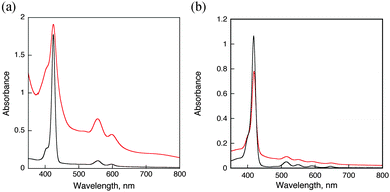 | ||
| Fig. 1 UV-vis absorption spectra of PhCN solutions of MTPPS4− (black) and electrodes of OTE/SnO2–(MTPPS4−–Li+@C60)n (red), M = (a) Zn and (b) H2. | ||
TEM was used to evaluate the topography of an OTE/SnO2–(MTPPS4−–Li+@C60)n film as shown in Fig. 2. The (MTPPS4−–Li+@C60)n films are composed of closely packed MTPPS4− and Li+@C60 composite clusters of about 80 nm in size, which renders a nanoporous morphology to the film. The cluster sizes were also evaluated by the dynamic light scattering (DLS) measurements (see Fig. S1 in the ESI†). The grape bunch morphology of the cluster assembly thus provides a high surface area to the electrophoretically deposited film of Li+@C60 clusters. As indicated earlier,11 charging of porphyrin and fullerene moieties in the DC electric field plays an important role in the growth and deposition process. These films are quite robust and can be washed with organic solvents to remove any loosely bound MTPPS4− and Li+@C60 nano-assemblies.
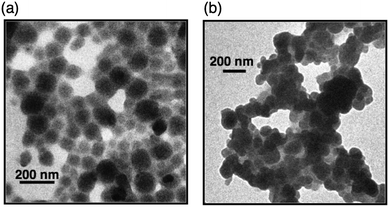 | ||
| Fig. 2 TEM images of (a) Li+@C60–ZnTPPS4− and (b) Li+@C60–H2TPPS4− nanoclusters. | ||
Photoelectrochemical measurements were performed using a standard two-electrode system consisting of a working electrode and a Pt wire gauze electrode in air-saturated MeCN containing 0.5 M LiI and 0.01 M I2 (Scheme 1). In order to evaluate the response towards the photocurrent generation, a series of photocurrent action spectra were recorded. The IPCE (incident photon-to-photocurrent efficiency) values were calculated by normalizing the photocurrent values for incident light energy and intensity and using eqn (1),12
| IPCE (%) = 100 × 1240 × isc/(Iinc × λ) | (1) |
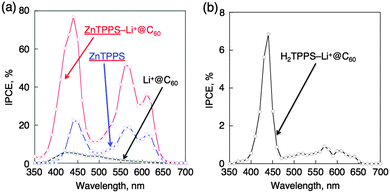 | ||
Fig. 3 Photocurrent action spectra of (a) OTE/SnO2–(ZnTPPS4−–Li+@C60)n (red), OTE/SnO2–(MTPPS4−–Li+@C60)n (blue) and OTE/SnO2–(Li+@C60)n (black) and (b) OTE/SnO2–(H2TPPS4−–Li+@C60)n. Electrolyte: 0.5 M LiI and 0.01 M I2 in MeCN–PhCN (3![[thin space (1/6-em)]](https://www.rsc.org/images/entities/char_2009.gif) : :![[thin space (1/6-em)]](https://www.rsc.org/images/entities/char_2009.gif) 1 v/v). 1 v/v). | ||
We have also evaluated the power characteristics of the OTE/SnO2–(ZnTPPS4−–Li+@C60)n electrode (Fig. S2 in the ESI†). The power conversion efficiency, η, is calculated using eqn (2):12
| η = FF × Isc × Voc/Win | (2) |
In order to clarify the photocurrent generation mechanism, we examined formation of the CS state [(ZnTPPS4−)˙+–Li+@C60˙−] by nanosecond laser flash photolysis measurements. Time-resolved transient absorption spectra of (ZnTPPS4−–Li+@C60)n dispersed in a deaerated MeCN–PhCN solution (3![[thin space (1/6-em)]](https://www.rsc.org/images/entities/char_2009.gif) :
:![[thin space (1/6-em)]](https://www.rsc.org/images/entities/char_2009.gif) 1 v/v) are shown in Fig. 4a, which clearly exhibit a broad absorption band at around 1035 nm.8,9 This is diagnostic of formation of Li+@C60˙− upon laser irradiation. Thus, photoinduced electron transfer occurs from ZnTPPS4− to Li+@C60 in the composite cluster to produce the CS state [(ZnTPPS4−)˙+–Li+@C60˙−]. The absorption time profile of [(ZnTPPS4−)˙+–Li+@C60˙−] recorded at 1035 nm is shown in Fig. 4b. The first-order decay kinetics (inset of Fig. 4b) corresponds to back electron transfer from Li+@C60˙− to (ZnTPPS4−)˙+, affording a rate constant of back electron transfer kBET = 4.6 × 103 s−1. The lifetime of the CS state is 220 μs, which is long enough to inject an electron from Li+@C60˙− of the CS state to the SnO2 electrode before the charge recombination. Such a long-lived CS state was further detected by EPR under photoirradiation of an MeCN–PhCN solution (1
1 v/v) are shown in Fig. 4a, which clearly exhibit a broad absorption band at around 1035 nm.8,9 This is diagnostic of formation of Li+@C60˙− upon laser irradiation. Thus, photoinduced electron transfer occurs from ZnTPPS4− to Li+@C60 in the composite cluster to produce the CS state [(ZnTPPS4−)˙+–Li+@C60˙−]. The absorption time profile of [(ZnTPPS4−)˙+–Li+@C60˙−] recorded at 1035 nm is shown in Fig. 4b. The first-order decay kinetics (inset of Fig. 4b) corresponds to back electron transfer from Li+@C60˙− to (ZnTPPS4−)˙+, affording a rate constant of back electron transfer kBET = 4.6 × 103 s−1. The lifetime of the CS state is 220 μs, which is long enough to inject an electron from Li+@C60˙− of the CS state to the SnO2 electrode before the charge recombination. Such a long-lived CS state was further detected by EPR under photoirradiation of an MeCN–PhCN solution (1![[thin space (1/6-em)]](https://www.rsc.org/images/entities/char_2009.gif) :
:![[thin space (1/6-em)]](https://www.rsc.org/images/entities/char_2009.gif) 3 v/v) containing (ZnTPPS4−–Li+@C60)n at 77 K. The EPR signal was observed at g = 2.0020, which is attributable to the mixture of the porphyrin radical cation (g = 2.002)14 and Li+@C60˙− (g = 2.0014) (see Fig. S3a in the ESI†).15 When ZnTPPS4− was replaced by H2TPPS4−, the transient absorption bands due to the CS state was significantly smaller than the case of ZnTPPS4− (Fig. S4, ESI†). This is the reason why the IPCE value of OTE/SnO2–(H2TPPS4−–Li+@C60)n was low as shown in Fig. 3b.
3 v/v) containing (ZnTPPS4−–Li+@C60)n at 77 K. The EPR signal was observed at g = 2.0020, which is attributable to the mixture of the porphyrin radical cation (g = 2.002)14 and Li+@C60˙− (g = 2.0014) (see Fig. S3a in the ESI†).15 When ZnTPPS4− was replaced by H2TPPS4−, the transient absorption bands due to the CS state was significantly smaller than the case of ZnTPPS4− (Fig. S4, ESI†). This is the reason why the IPCE value of OTE/SnO2–(H2TPPS4−–Li+@C60)n was low as shown in Fig. 3b.
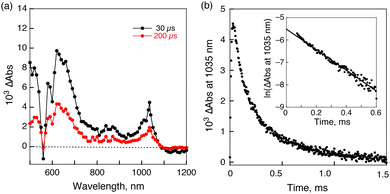 | ||
Fig. 4 (a) Transient absorption spectra of (ZnTPPS4−–Li+@C60)n in deaerated MeCN–PhCN (3![[thin space (1/6-em)]](https://www.rsc.org/images/entities/char_2009.gif) : :![[thin space (1/6-em)]](https://www.rsc.org/images/entities/char_2009.gif) 1 v/v) taken at 30 μs (black) and 200 μs (red) after laser excitation at 550 nm. (b) Time profile at 1035 nm. Inset: first-order analysis. 1 v/v) taken at 30 μs (black) and 200 μs (red) after laser excitation at 550 nm. (b) Time profile at 1035 nm. Inset: first-order analysis. | ||
Based on the above-mentioned results, the photocurrent generation is initiated by photoinduced electron transfer from ZnTPPS4− to Li+@C60 in the cluster to produce the CS state, (ZnTPPS4−)˙+–Li+@C60˙−. The reduced Li+@C60 (Li+@C60˙−) (E(Li+@C60/Li+@C60˙−) = 0.14 V vs. SCE)8,9 injects electrons into the conduction band of SnO2 (0.2 V vs. SCE),11 whereas the oxidized ZnTPPS4− (E(ZnTPPS4−/(ZnTPPS4−)˙+) = 0.74 V vs. SCE)8 undergoes the electron-transfer reduction with the iodide (I3−/I− = 0.7 V vs. SCE)12 in the electrolyte solution.
In conclusion, the photoinduced electron transfer from ZnTPPS4− to Li+@C60 in the supramolecular cluster makes it possible to enhance the performance of the photoelectro-chemical cell. Thus, the use of Li+@C60 as an electron acceptor in the supramolecular clusters with ZnTPPS4− paves a new way for the design of high performance solar cells.
This work was supported by Grant-in-Aids for Scientific Research (No. 23750014 to K.O.; No. 23108721 & 23681025 to T.H.; No. 20108010 to S.F.), the Science Research Promotion Fund from the Promotion and Mutual Aid Corporation for Private Schools from MEXT, Japan, and a WCU project (R31-2008-000-10010-0) through KOSEF/MEST, Korea.
References
- (a) M. Grätzel, Nature, 2003, 421, 586 CrossRef; (b) M. Grätzel, Nature, 2001, 414, 338 CrossRef; (c) B. O'Regan and M. Grätzel, Nature, 1991, 353, 737 CrossRef CAS.
- (a) A. Hagfeldt and M. Grätzel, Chem. Rev., 1995, 95, 49 CrossRef CAS; (b) A. Hagfeldt and M. Grätzel, Acc. Chem. Res., 2000, 33, 269 CrossRef CAS.
- (a) W. U. Huynh, J. J. Dittmer and A. P. Alivisatos, Science, 2002, 295, 2425 CrossRef CAS; (b) A. Shah, P. Torres, R. Tscharner, N. Wyrsch and H. Keppner, Science, 1999, 285, 692 CrossRef CAS.
- The Photosynthetic Reaction Center, ed. J. Deisenhofer and J. R. Norris, Academic Press, San Diego, 1993 Search PubMed.
- (a) T. Hasobe, Phys. Chem. Chem. Phys., 2012, 14, 15975 RSC; (b) H. Imahori and S. Fukuzumi, Adv. Mater., 2001, 13, 1197 CrossRef CAS.
- (a) M. Lahav, V. Heleg-Shabtai, J. Wasserman, E. Katz, I. Willner, H. Dürr, Y.-Z. Hu and S. H. Bossmann, J. Am. Chem. Soc., 2000, 122, 11480 CrossRef CAS; (b) J.-F. Eckert, J.-F. Nicoud, J.-F. Nierengarten, S.-G. Liu, L. Echegoyen, F. Barigelletti, N. Armaroli, L. Ouali, V. Krasnikov and G. Hadziioannou, J. Am. Chem. Soc., 2000, 122, 7467 CrossRef CAS.
- S. Fukuzumi and D. M. Guldi, in Electron Transfer in Chemistry, ed. V. Balzani, Wiley-VCH, Weinheim, 2001, vol. 2, pp. 270–337 Search PubMed.
- K. Ohkubo, Y. Kawashima and S. Fukuzumi, Chem. Commun., 2012, 48, 4314 RSC.
- (a) S. Fukuzumi, K. Ohkubo, Y. Kawashima, D. S. Kim, J. S. Park, A. Jana, V. M. Lynch, D. Kim and J. L. Sessler, J. Am. Chem. Soc., 2011, 133, 15938 CrossRef CAS; (b) Y. Kawashima, K. Ohkubo and S. Fukuzumi, J. Phys. Chem. A, 2012, 116, 8942 CrossRef CAS; (c) T. Kamimura, K. Ohkubo, Y. Kawashima, H. Nobukuni, Y. Naruta, F. Tani and S. Fukuzumi, Chem. Sci., 2013, 3, 1451 RSC.
- H. Nobukuni, F. Tani, Y. Shimazaki, Y. Naruta, K. Ohkubo, T. Nakanishi, T. Kojima, S. Fukuzumi and S. Seki, J. Phys. Chem. C, 2009, 113, 19694 CAS.
- T. Hasobe, H. Imahori, S. Fukuzumi and P. V. Kamat, J. Phys. Chem. B, 2003, 107, 12105 CrossRef CAS.
- T. Hasobe, Y. Kashiwagi, M. A. Absalom, J. Sly, K. Hosomizu, M. J. Crossley, H. Imahori, P. V. Kamat and S. Fukuzumi, Adv. Mater., 2004, 16, 975 CrossRef CAS.
- H. Matsuzawa, H. Kobayashi and T. Maeda, Bull. Chem. Soc. Jpn., 2012, 85, 774 CrossRef CAS.
- S. Fukuzumi, K. Saito, K. Ohkubo, T. Khoury, Y. Kashiwagi, M. A. Absalom, S. Gadde, F. D'Souza, Y. Araki, O. Ito and M. J. Crossley, Chem. Commun., 2011, 47, 7980 RSC.
- Li+@C60˙− was prepared by the electron transfer from dimeric 1-benzyl-1,4-dihydronicotinamide to Li+@C60,9a which was observed at 100 K by ESR (see Fig. S3b in the ESI†).
Footnote |
| † Electronic supplementary information (ESI) available: Spectral data and experimental details. See DOI: 10.1039/c3cc41187g |
| This journal is © The Royal Society of Chemistry 2013 |
